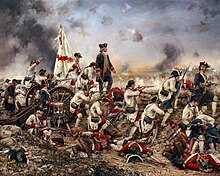| Anglo-Spanish War (1779–1783) | |||||||||
|---|---|---|---|---|---|---|---|---|---|
| Part of the American Revolutionary War and the Anglo-Spanish Wars | |||||||||
 Bernardo de Gálvez at the siege of Pensacola, painting by Augusto Ferrer-Dalmau | |||||||||
| |||||||||
| Belligerents | |||||||||
|
|
| ||||||||
| Commanders and leaders | |||||||||
|
Bernardo de Gálvez, Matías de Gálvez, Luis de Córdova y Córdova, Juan de Lángara |
George Brydges Rodney, Richard Howe, George Augustus Eliott, John Campbell | ||||||||
Spain, through its alliance with France and as part of its conflict with Britain, played a role in the independence of the United States. Spain declared war on Britain as an ally of France, itself an ally of the American colonies. Most notably, Spanish forces attacked British positions in the south and captured West Florida from Britain in the siege of Pensacola. This secured the southern route for supplies and closed off the possibility of any British offensive through the western frontier of the United States via the Mississippi River. Spain also provided money, supplies, and munitions to the American forces.
Beginning in 1776, it jointly funded Roderigue Hortalez and Company, a trading company that provided critical military supplies. Spain provided financing for the final siege of Yorktown in 1781 with a collection of gold and silver in Havana, then Spanish Cuba.[1] Spain was allied with France through the Bourbon Family Compact and the Revolution was an opportunity to confront their common enemy, Great Britain. As the newly appointed Chief Minister of King Charles III of Spain, the Count of Floridablanca wrote in March 1777, "the fate of the colonies interests us very much, and we shall do for them everything that circumstances permit".[2]
- ^ Thomas E. Chavez (January 2004). Spain and the Independence of the United States: An Intrinsic Gift. UNM Press. p. 225. ISBN 978-0-8263-2794-9.
- ^ Fernández y Fernández, p. 4